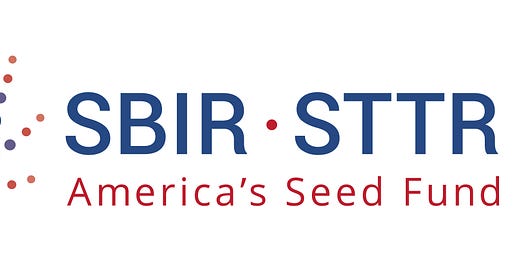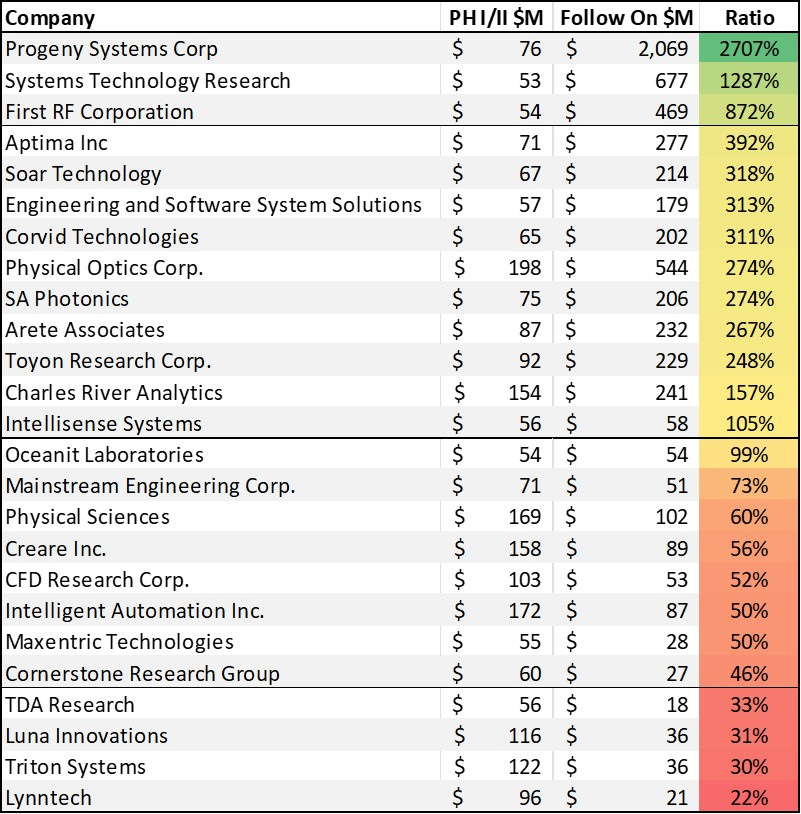Shaping SBIR Strategies to Maximize Impact
Look at ROI Track Record and Transition Potential in SBIR Awards
Amanda and Alex Bresler continue to do amazing Small Business Innovation Research (SBIR) analysis, with their latest work published in Contract Management Magazine.
They assessed from 2012 to 2021 over $13B in SBIR/STTR funding was distributed across nearly 6,000 awards. These awards went to 2,190 distinct entities (companies).
The top 25 companies cumulatively received 18% of all DoD SBIR/STTR Phase I/ Phase II funding, more than $2.3B from FY2012-FY2021.
24/25 received DoD Phase I/II SBIR/ STTR awards for more than 10 years.
20/25 were awarded DoD Phase I/II funding for more than 20 years.
Only 4/25 DoD SBIR companies generated more in DoD Phase III contracts than they received in non-dilutive Phase I/ Phase II awards.
Only 9/25 companies fell in the top 10% of DoD SBIR companies receiving the most Phase III contract dollars.
They previously determined that from FY2010-FY2019
90% of DoD Phase I funds were awarded to current DoD vendors.
The top 5% of DoD SBIR companies with the most in DoD Phase I/Phase II awards received 51% of all Phase I/II funding.
Their leading conclusion was DoD’s poor transition rate from Phase I and II awards.
In reviewing their article, I decided to geek out on some of the numbers to do some follow-on analysis. Leveraging their transition metrics from Figure 4, I simplified and resorted the data.
These are the Top 25 companies to receive SBIR/STTR funding from FY12-21. The ratio is the amount of follow-on funding (Phase III, non-SBIR funding, and sub-contract work) / Phase I/II funding.
SBIR/STTR is America’s Seed Fund for technology innovation. One would expect investing ~$75K in Phase I and ~$750K in Phase II would then lead to many millions of follow-on work for the most successful research.
The top 3 on this list received $53-76M in SBIR Phase I/II awards which led to over $3B in follow-on work.
Progeny Systems “develops and produces innovative hardware and software solutions for the DoD and other organizations”.
Systems Technology Research “is built on people and technology platforms tackling tough problems in cybersecurity, distributed sensing, and artificial intelligence to deliver mission performance.”
First RF Corporation “are an advanced technologies company specializing in antennas and RF systems.”
These are clearly model companies for the SBIR/STTR program who are generating 9X-27X returns on research investments. Similarly, there are companies below the top 25 list that also generate significant follow-on work.
At the other end of the spectrum are four companies that DoD has invested nearly $400M in their research which yielded only $112M in follow-on work. One would need to unpack the individual awards to understand why this is. This limited data does not conclude these are all bad companies or bad research. Factors could be:
DoD did not see value in their Phase I/II research to warrant funding further.
The DoD’s technology priorities shifted away from their research area.
DoD and Congress did not fund follow-on work building on the research.
Their research proved a technology or application was not a viable solution for DoD’s needs. Think of the adage from Edison discovering 10,000 ways not to invent a lightbulb.
Another company offered a better solution in competing for follow-on work.
The data in the chart does not reflect all their DoD follow-on work.
The research led to new commercial opportunities which may have been valuable from an economic and technology advancement perspective outside of DoD.
Or the SBIR Phase II, with some minor follow-on work provided DoD a valuable materiel solution.
However, taking a step back, $400M in SBIR/STTR awards that average $75/$750K is 500-5,000 awards for FOUR companies. Four companies receiving hundreds of SBIR/STTR awards with follow-on work at tiny fraction of their research funds is a horrible track record. One would think after 100 awards with little to show for it, one would question selecting them again.
Update: Based on Ben Van Roo’s expert SBIR analysis that I forgot to reference, these four companies received 1,357 SBIR Phase I and II awards.
As the Breslers stress, past performance in tech transition should be a factor in SBIR/STTR awards.
Ultimately it goes to mission impact. How is DOD exploiting novel technologies from America’s small business and translating it into defense solutions for our warfighters? Funding does not equate to impact. DoD has wasted billions on major systems that were cancelled or proven useless after a few years. Similarly, there are capabilities that cost a few million that have had a tremendous impact in operations. Or the SBIR awards provided the small business additional runway which led to another breakthrough solution.
DoD, Congress, and Industry need to have a series of in-depth discussions on how to improve SBIR/STTR strategies to maximize ROI.




